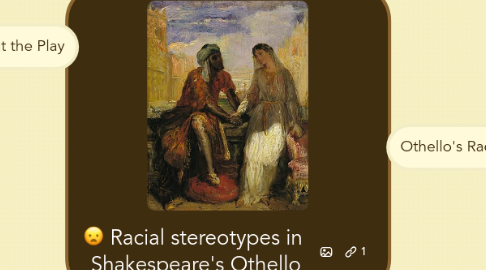
1. Tragedy
2. Written between 1601 and 1604
3. About the Play
3.1. Inspiration
3.1.1. Othello possibly inspired by Abd el-Ouahed ben Messaoud ben Mohammed Anoun, Moorish ambassador of the Arab King of Barbary to Queen Elizabeth I in 1600
3.2. Based on
3.2.1. Italian shortstory "Un Capitano Moro" by Cinthio, a disciple of Boccaccio, first published in 1565
3.3. First interpreter
3.3.1. Almost certainly Richard Burbage
3.3.1.1. 1
3.3.1.2. 2
3.4. SUMMARY
3.5. THEMES
3.5.1. Love
3.5.2. Jealousy
3.5.3. Racism
3.5.4. Betrayal
4. Performance
4.1. 19th century
4.1.1. Frequently performed as Arab Moor
4.1.2. Often by white actor in blackface
4.2. 1930 to 1959
4.2.1. Black American actor Paul Robeson
4.3. Since 1960s
4.3.1. Commonplace to cast black actor as Othello
4.4. 1965
4.4.1. Lawrence Olivier
4.5. 2004
4.5.1. Black English actor Wil Johnson
5. Read the complete text online here
6. Othello's Race
6.1. Race is ambiguous
6.1.1. "Moor"
6.1.1.1. dark-skinned people
6.1.1.1.1. "African"
6.1.1.1.2. "Negro"
6.1.1.1.3. "Indian"
6.1.2. "black"
6.1.2.1. "swarthy"
6.1.2.2. negative connotations
6.1.3. "sooty bosom"
6.1.3.1. racial stereotype
6.2. Most likely Sub-Saharan
6.2.1. Otherwise would have been more easily accepted
6.2.2. "thick lips"
6.2.3. But: "Barbary", "Barbary horse"
6.2.3.1. Barbary coast
